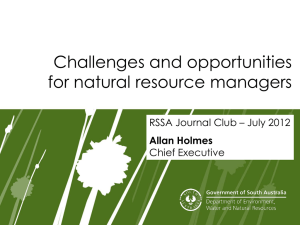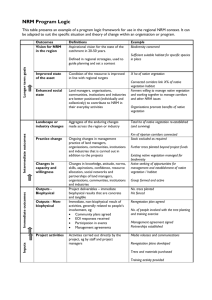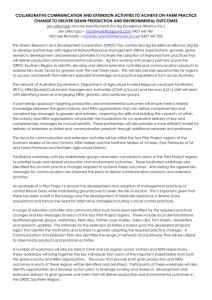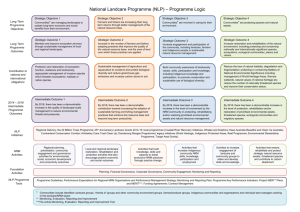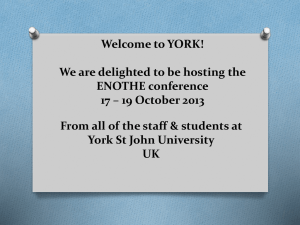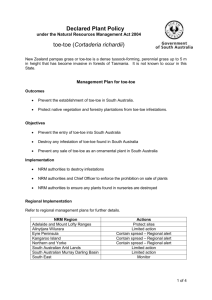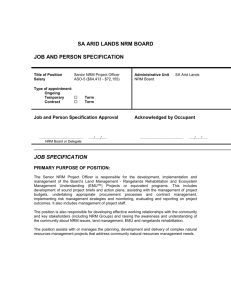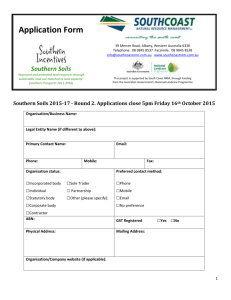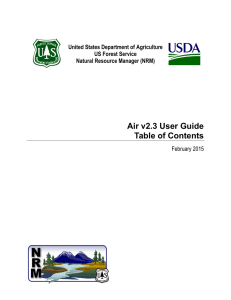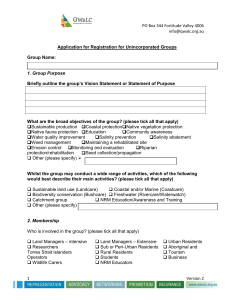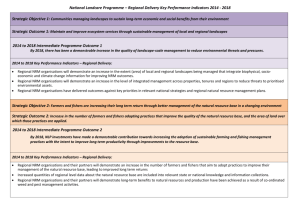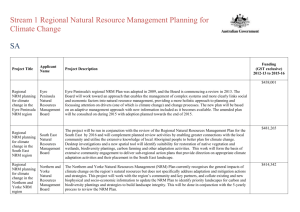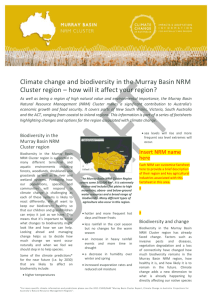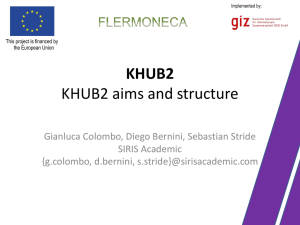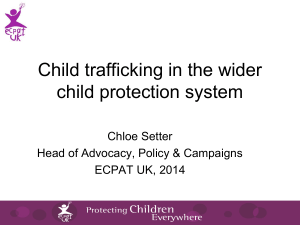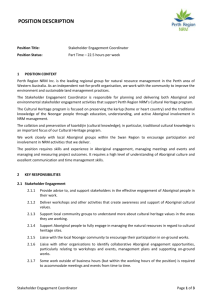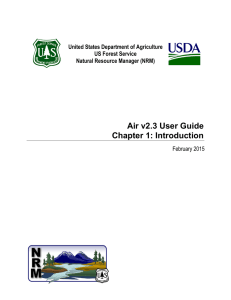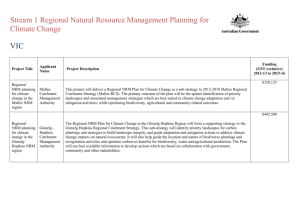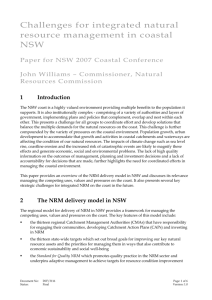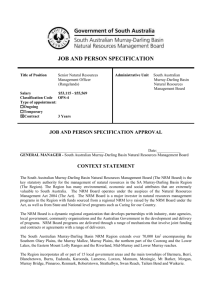Emissions Reduction Fund Green Paper submission 010214
advertisement
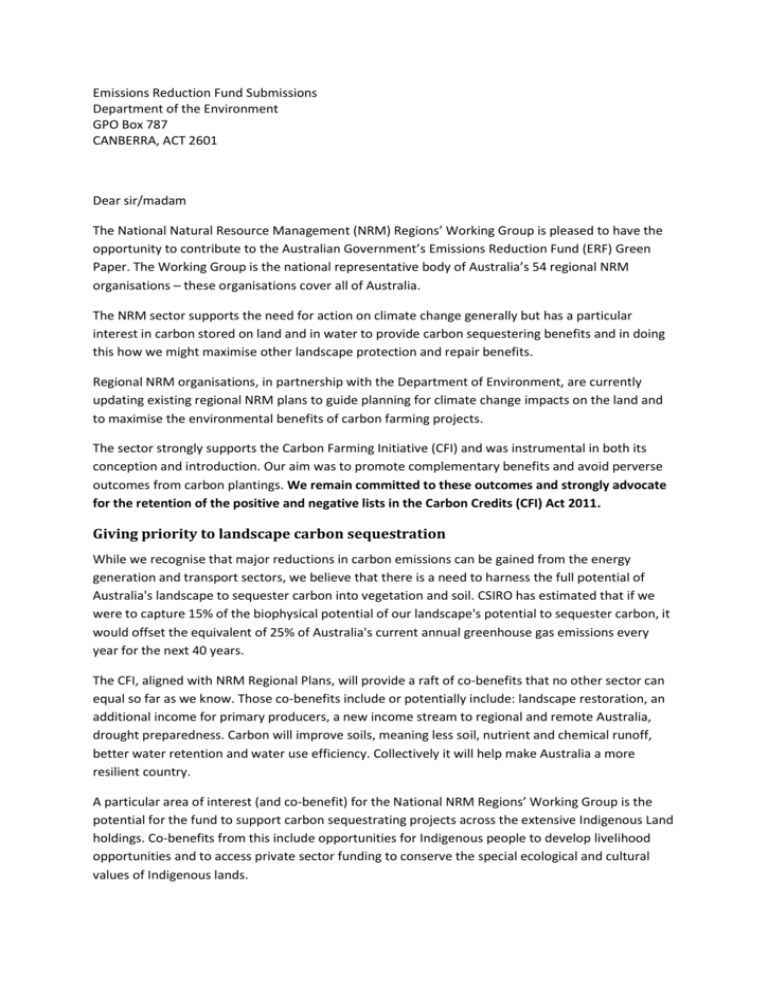
Emissions Reduction Fund Submissions Department of the Environment GPO Box 787 CANBERRA, ACT 2601 Dear sir/madam The National Natural Resource Management (NRM) Regions’ Working Group is pleased to have the opportunity to contribute to the Australian Government’s Emissions Reduction Fund (ERF) Green Paper. The Working Group is the national representative body of Australia’s 54 regional NRM organisations – these organisations cover all of Australia. The NRM sector supports the need for action on climate change generally but has a particular interest in carbon stored on land and in water to provide carbon sequestering benefits and in doing this how we might maximise other landscape protection and repair benefits. Regional NRM organisations, in partnership with the Department of Environment, are currently updating existing regional NRM plans to guide planning for climate change impacts on the land and to maximise the environmental benefits of carbon farming projects. The sector strongly supports the Carbon Farming Initiative (CFI) and was instrumental in both its conception and introduction. Our aim was to promote complementary benefits and avoid perverse outcomes from carbon plantings. We remain committed to these outcomes and strongly advocate for the retention of the positive and negative lists in the Carbon Credits (CFI) Act 2011. Giving priority to landscape carbon sequestration While we recognise that major reductions in carbon emissions can be gained from the energy generation and transport sectors, we believe that there is a need to harness the full potential of Australia's landscape to sequester carbon into vegetation and soil. CSIRO has estimated that if we were to capture 15% of the biophysical potential of our landscape's potential to sequester carbon, it would offset the equivalent of 25% of Australia's current annual greenhouse gas emissions every year for the next 40 years. The CFI, aligned with NRM Regional Plans, will provide a raft of co-benefits that no other sector can equal so far as we know. Those co-benefits include or potentially include: landscape restoration, an additional income for primary producers, a new income stream to regional and remote Australia, drought preparedness. Carbon will improve soils, meaning less soil, nutrient and chemical runoff, better water retention and water use efficiency. Collectively it will help make Australia a more resilient country. A particular area of interest (and co-benefit) for the National NRM Regions’ Working Group is the potential for the fund to support carbon sequestrating projects across the extensive Indigenous Land holdings. Co-benefits from this include opportunities for Indigenous people to develop livelihood opportunities and to access private sector funding to conserve the special ecological and cultural values of Indigenous lands. Given the taxpayer contribution to the ERF it is argued the government should maximise the public good outcomes from its investment. It is understood from the Green Paper that the government will seek the lowest cost carbon but the NRM sector’s concern is that a very low price on carbon would fund very few landscape restoration activities. For example, could a small number of large industrial or international projects use up the entire ERF? If so there would be no investment in land and water carbon from the Fund. While this would reduce emissions at the lowest cost, there would be no co-benefits. On the other hand if a significant amount from the Fund went into land and water carbon and it led to widespread uptake there would be a measurable improvement in landscape health, sustainable practice, farm income, and regional economies. Rangelands Our Rangeland Alliance colleagues are preparing their own submission, but we note and support their estimation that restoring the Rangelands of Australia has the potential to sequester 100 Million Tonnes of CO2e per year for 40 years. In the short term improved herd management could lead to an additional 20% reduction in greenhouse gas emissions with an 80% reduction possible by 2050. The Alliance draws attention to the significant barriers they face to participation in the Carbon Farming Initiative and the Emissions Reduction Fund and advocates for a program that provides significant economic, social and environmental outcomes across this region for Indigenous Australians, agricultural enterprises and significant areas of native flora and fauna habitat. The NRM sector therefore proposes the Australian Government considers setting aside a portion of the fund for land and water carbon or weighting assessment in favour of projects with measurable co-benefits (i.e. would meet a priority activity in a regional NRM Plan). Aggregation Regional NRM plans, all of which are currently being “carbonised” to ensure the CFI delivers cobenefits, rather than perverse outcomes, provide an opportunity for aggregation landscape carbon sequestering at a regional scale. Some regional NRM organisations have recognised the potential for them to play a role as “aggregator” of small sequestration activities. But this will require support. A component of funding for land and water carbon could be allocated to support the aggregation process. Expanding the CFI Widespread adoption will also require the speeding up of methodology approval. The move to speed up methodology approval and to use existing international methodologies is supported. We would be happy to discuss these ideas with you further, Yours sincerely Pamela Green Chair, National NRM Regions’ Working Group
